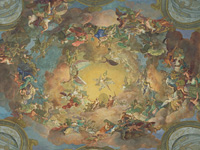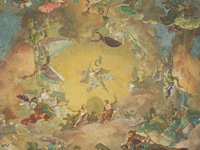The frescos in the cupola
|
In the centre of the cupola fresco there is, looking from the “peace wing”, a medallion with a picture of Charles VI held up by Hercules and Apollo. Strength and wisdom, represented by the figures of Hercules and Apollo, are the characteristics attributed to the Emperor. Over his likeness hovers the figure of eternal glory holding a pyramid (a symbol of honour) in its right arm. In the inner circle of the cupola bowl is to be found Fama with two trumpets, the “glory of the House of Habsburg” with the motto A.E.I.O.U and the representation of the arts of ruling and war making. That closes the circle of the main imperial characteristics. Depicted in a wider circle are actions, characteristics, virtues and vices that make a transition into the secular world. The “Emperor’s love of magnificence”, surrounded by “generosity” and Austrian magnanimity, delivers, with a sceptre held pointing downwards, to the art of construction the order to build the Court Library. At that, "Germania" and the “City of Vienna” rejoice. The “constancy” and “strength” of the Emperor are manifested in the following allegorical group that shows Mars with a column and a lion. This group is joined by the four faculties and the figure of gratitude and of history. A medallion of Emperor Maximilian I and a stone relief of the Hungarian king Matthias Corvinus close the circle of the historical exemplars for the imperial book collection. If the cupola painting is looked at from the side of the War Wing, the first thing that strikes the eye is a scene in which the goddess of peace offers Minerva an olive branch. To her left are geniuses with books and treasures, to her right the enemies of erudition are falling from Heaven. Visible above that is Fortuna with the full sail and the figure of glory above the picture of Charles VI. Hence we see the meaning of the frescos, the interweaving of universal opposites under the figure of the Baroque ruler in the passage through the Hall. The art of Daniel Grans consisted, besides the exploitation of all the European traditions of Baroque painting, in the linking of painting, architecture, and iconography in an allegorical presentation of history. |



